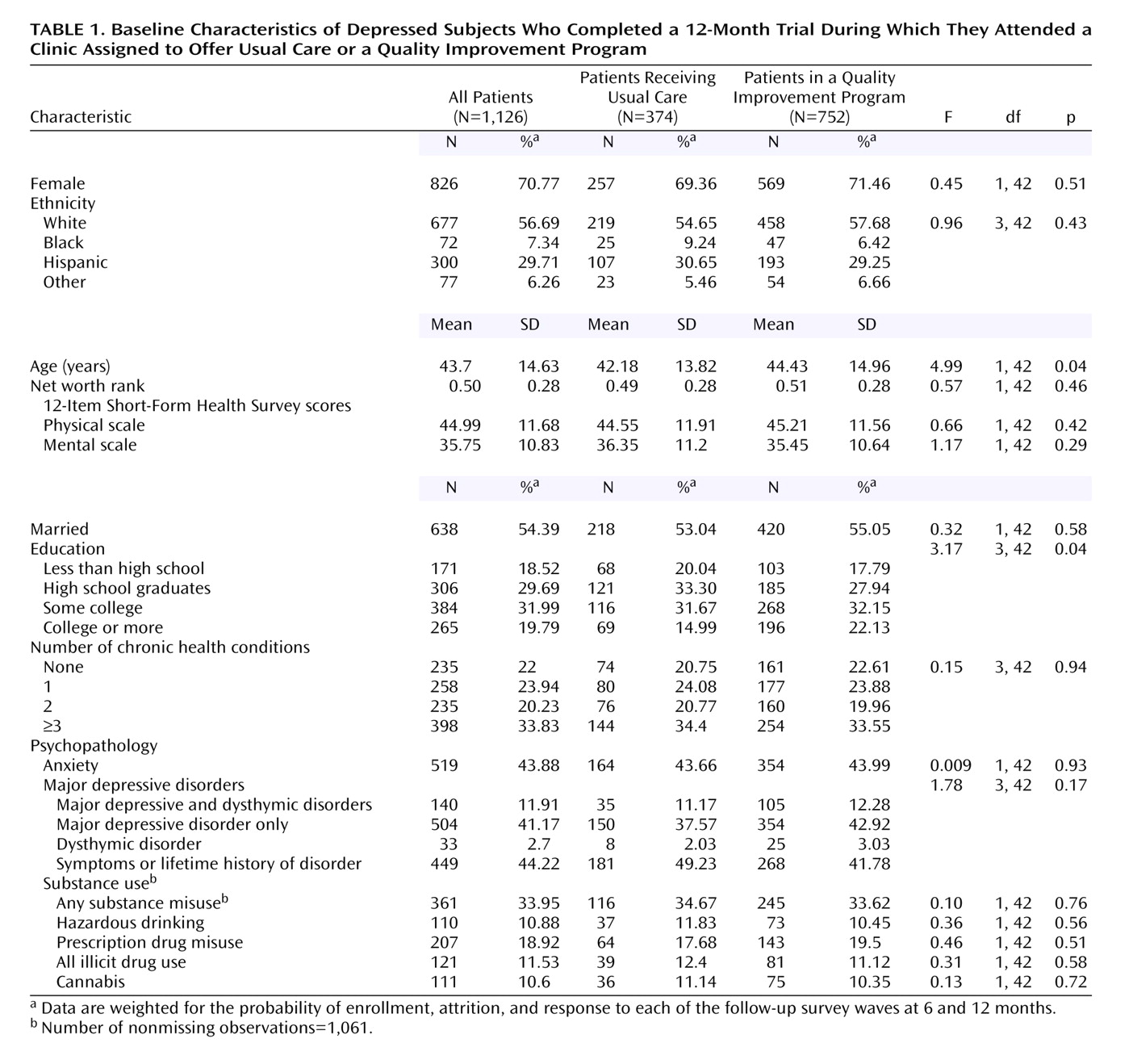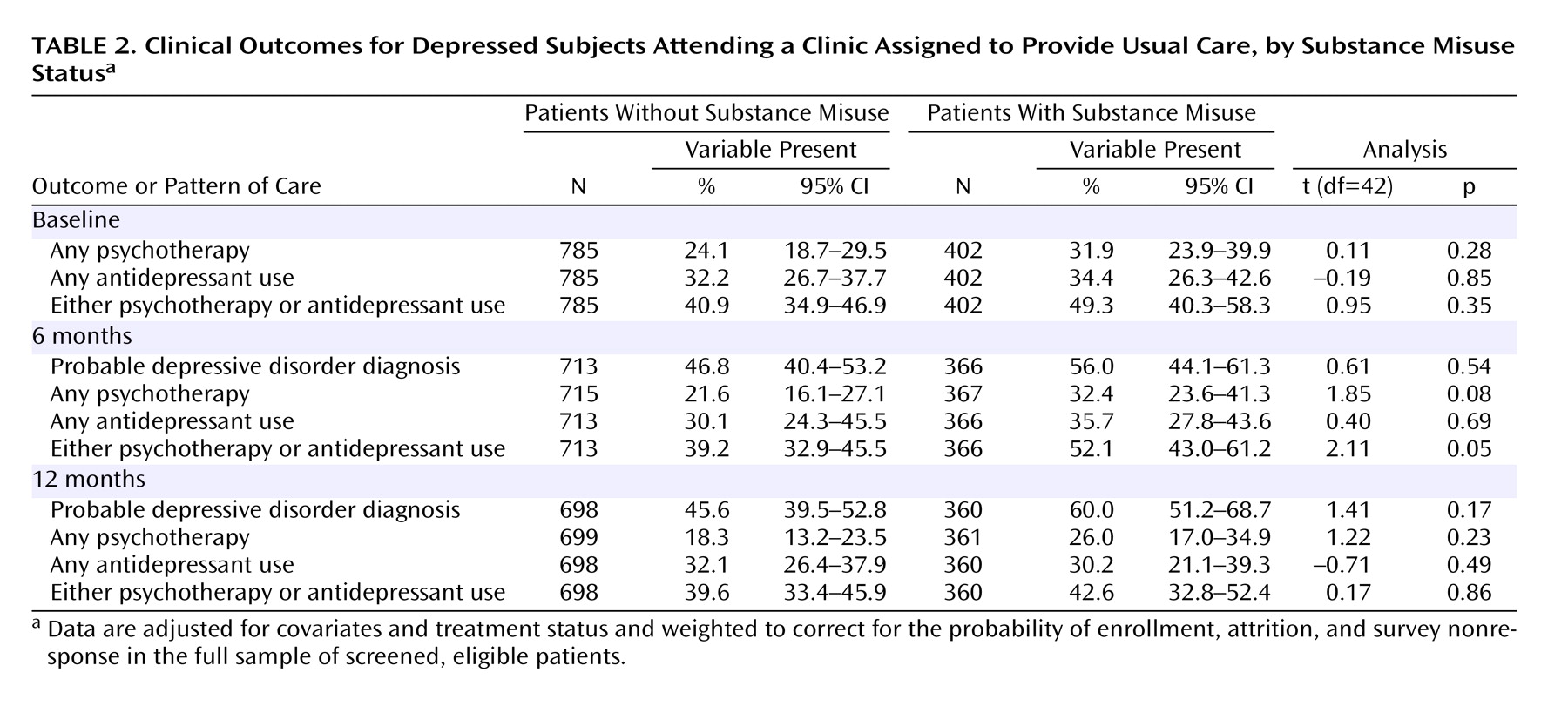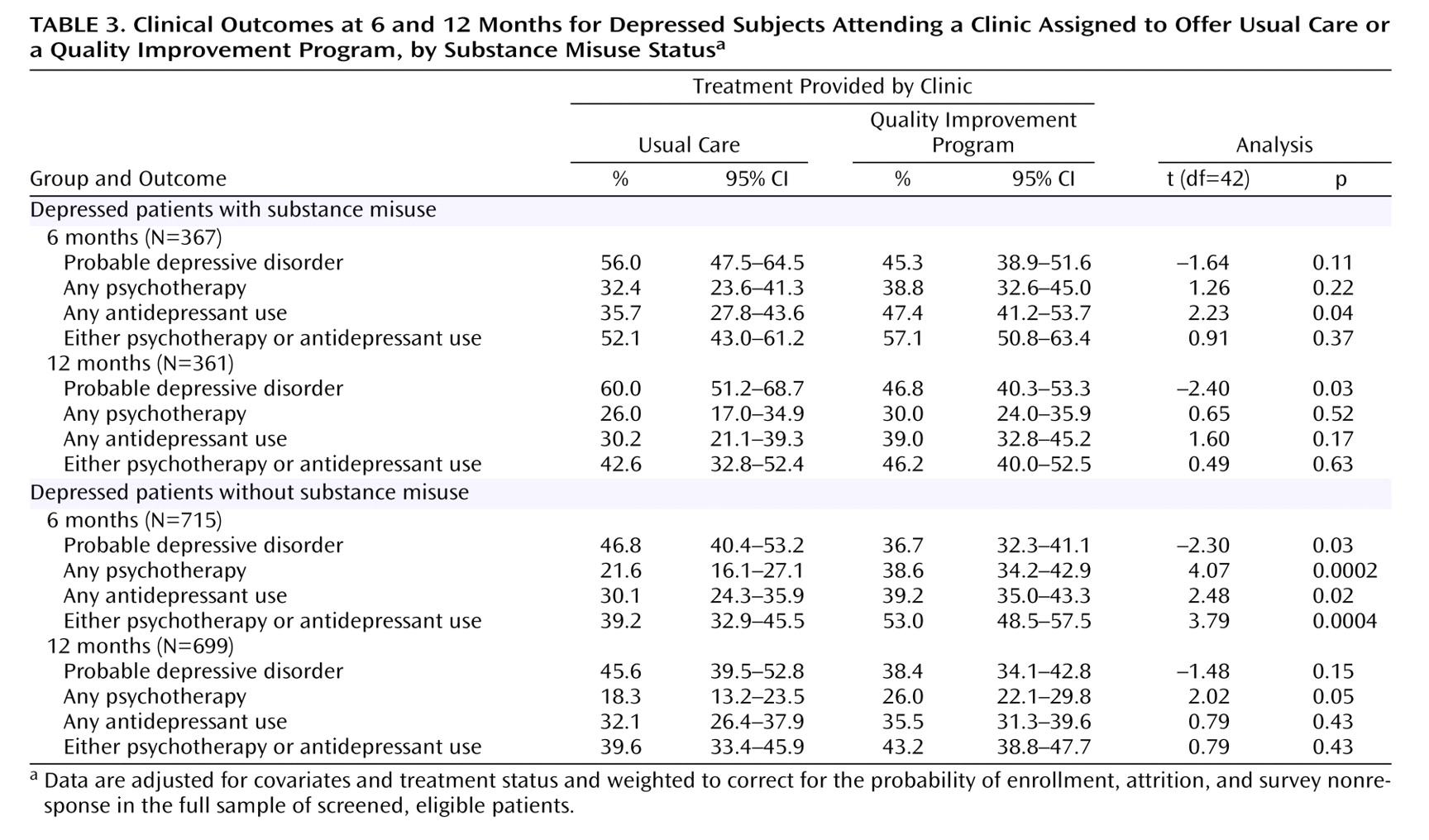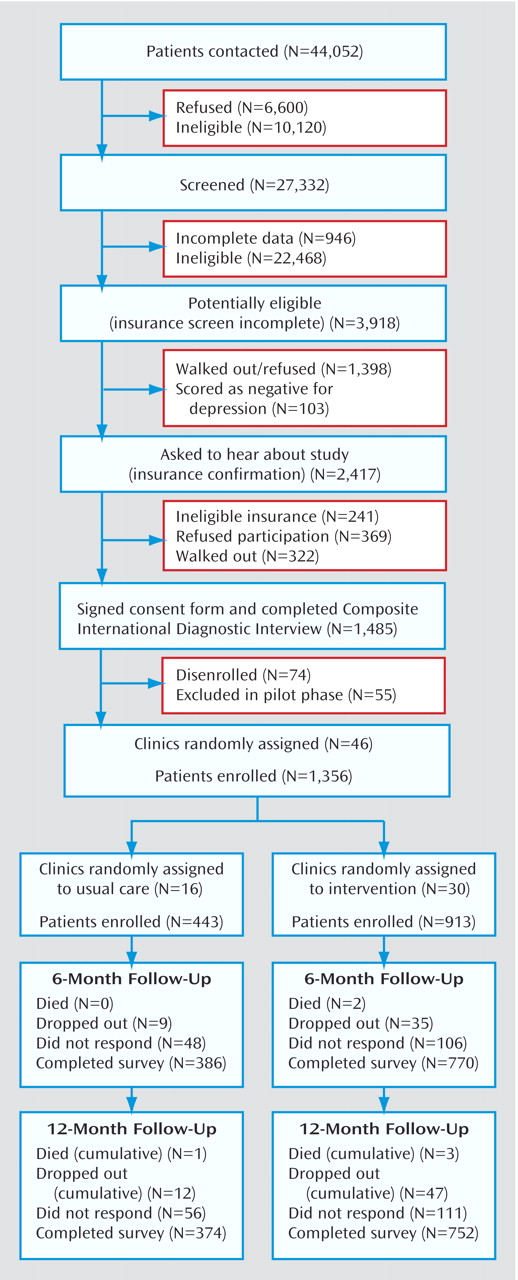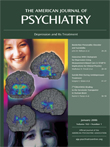Substance misuse is common among people with depressive disorders, and the co-occurrence of substance misuse and depression is associated with greater impairment and worse treatment outcomes than in individuals with either disorder alone
(1–
6). National data suggest that among individuals with an episode of major depression in the past year, 21% had an alcohol use disorder and 9% had a drug use disorder; many more have substance misuse but not abuse or dependence
(7,
8). Among primary care patients with depression, more than one-quarter report substance misuse; some of these have abuse or dependence
(9). The quality of care for co-occurring disorders is low, and the majority of people with co-occurring disorders do not receive either mental health or substance abuse care
(10,
11).
The quality of care for depressive disorders can be improved by practice-based quality improvement interventions that lead to increased rates of treatment and improved clinical outcomes
(12,
13). These interventions work in primary care settings among clients with and without comorbid medical illnesses
(14) and among men and women
(15), but it is not known whether such programs are effective for individuals with depression and substance misuse.
There are several reasons to suspect that a quality improvement intervention might have a different effect among individuals with co-occurring substance misuse. The presence of comorbid substance misuse complicates the diagnosis and treatment of depression, with some experts recommending psychotherapy and a period of abstinence before initiating pharmacotherapy, whereas others offer antidepressant treatment to clients even when substance use is ongoing
(16–
18). Treatments for depression are thought to be less effective among substance users
(4), although some studies suggest that treatment is effective even among those who use alcohol
(19) or other drugs
(20,
21). Patterns of care may also differ, since 1) providers may be more likely to provide psychotherapy than medication to depressed patients with co-occurring substance misuse, and 2) behavioral treatments carry little or no risk to the patient and can be initiated early in treatment when a formal diagnosis of depression is still uncertain
(22–
24).
We used data from the Partners in Care trial to investigate whether quality improvement programs for depression would be effective among substance misusers
(25). We hypothesized that 1) under usual care conditions, depressed primary care patients with comorbid substance misuse would have a higher probability of ongoing depression, lower rates of antidepressant use and overall appropriate treatment, and higher rates of psychotherapy at 6 and 12 months than patients without comorbid substance misuse; and 2) quality improvement programs for depression would be effective among substance abusers as well as nonusers and would improve rates of overall appropriate treatment.
Method
Study Design
Partners in Care was a group-level, randomized controlled trial involving six managed care organizations in five states that compared two quality improvement programs for depression with usual care. It included staff and network model multispecialty group practices and rural managed public health clinics; patients had prepaid or managed fee-for-service coverage. Clinics were selected to oversample Mexican Americans and to be diverse in geography and organization
(25). Forty-six of 48 primary care clinics participated, and 181 of 183 primary care providers agreed to participate. Forty-six clinics were grouped into nine blocks of three clinic clusters each, matched for patient demographics, clinician specialty, and proximity to a mental health provider. Within each block, clinics were randomly assigned to provide usual care or one of two quality improvement interventions (medication or therapy).
As seen in
Figure 1, study staff screened 27,332 consecutive patients over a 57-month period between June 1996 and March 1997. Patients were eligible if they intended to use the practice for 12 months and screened positive for current depressive symptoms plus probable major depressive or dysthymic disorder in the preceding year. Patients were ineligible if they were under 18 years of age, not fluent in English or Spanish, or if practice providers or therapists participating in the interventions were not covered by their insurance. The study was approved by the institutional review boards of RAND and the practices.
Of those completing the screening assessment, 3,918 were potentially eligible, but many left the clinic before the study could check insurance status; 2,417 were available for confirming insurance, and 241 (10%) had ineligible insurance. Of those who provided written informed consent, 1,356 (70%) were enrolled; 443 received usual care, with the remaining subjects split between the two quality improvement programs (medication [N=424] or therapy [N=489]).
Intervention Conditions
The quality improvement programs were based on the patient and provider behavior change literature and were implemented by the local managed care organization. The goal of the intervention was to increase the proportion of depressed patients who received appropriate care, defined as either antidepressant medication or psychotherapy. Both quality improvement programs involved 1) institutional commitment in the form of resources to support the intervention model, matched by the study; 2) a local interdisciplinary clinical team trained by the study to provide oversight to intervention implementation, supervise intervention staff, and provide monthly quality review of cases; 3) education for local clinicians, provided by the local quality review team; 4) nurse depression specialists, trained by the study, who were available to help with initial clinical assessments and educate patients to facilitate treatment decisions; and 5) toolkits to support these activities, developed by the study and disseminated by the local quality review team and intervention staff. All intervention toolkit materials are available on the RAND web site (http://www.rand.org/organization/health), and all patient materials are available in English and Spanish.
The quality improvement program involving medication provided enhanced resources for supporting medication management that included ongoing access to a depression nurse specialist in the role of case manager for 6–12 months. The quality improvement program involving psychotherapy provided enhanced resources for psychotherapy for depression, including trained local psychotherapists who offered individual or group cognitive behavior therapy
(26,
27) that included a brief four-session form of cognitive behavior therapy for patients with minor depression. However, patients could also use other practice therapy. Usual care consisted of providing the clinic directors with copies of written practice guidelines for depression in primary care, with no other study assistance. Clinicians and patients in all three arms were free to choose the type of treatment provided or no treatment. Previous work
(28) has described adherence to the intervention protocol and changes in the process of care.
Modifications for Substance Abuse
The nurse specialists were trained to screen for a current substance use disorder and provide that information to the primary care doctor on a simple checklist. The clinician manual included encouragement to screen for a comorbid substance use disorder and discussed options for care. For people with abuse or dependence, the manual recommended referral to a psychiatrist or a comprehensive substance abuse treatment program with a reevaluation in 1–2 months. For people with at-risk drinking, the manual recommended referral to self-help groups and counseling about limiting alcohol use; depression treatment was considered if the patient could maintain sobriety for at least 1 month and had persistent depressive symptoms.
Measures
We used the Composite International Diagnostic Interview
(29) to assess major depression and dysthymia at baseline, 6, and 12 months. Patients were categorized as having a probable depressive disorder if they endorsed any stem item for major depression or dysthymia in the preceding year and were positive for any item in the preceding month as well. Hazardous drinking was measured with the Alcohol Use Disorders Identification Test; we used a cutoff score of 8 out of 40, which has a sensitivity of 96% and a specificity of 98% for hazardous alcohol consumption
(30–
33). The drug misuse assessment instrument was modified from a validated substance abuse screener
(34), and drug misuse was defined as use of either legal or illegal substances without a doctor’s prescription, in greater amounts or more often than prescribed, or for a reason other than a doctor’s recommendation. Drug categories included cannabis, sedatives and tranquilizers, opiates, cocaine and crack, amphetamines, psychedelics, and inhalants
(9).
Each survey assessed antidepressant use and use of specialty counseling, and indicators of medication and psychotherapy treatment were developed. Since both psychotherapy and antidepressants are appropriate treatments for depression, we considered the presence of either during a given 6-month period as appropriate treatment and pooled the results of the two quality improvement interventions. Previous work indicates that both approaches improved treatment rates as well as clinical outcomes and health-related quality of life
(12,
13)Subjects
Table 1 shows the characteristics of all subjects who remained in the study at the 12-month follow-up assessment, with a comparison of those attending a clinic assigned to provide usual care and those attending a clinic providing a quality improvement program. Substance misuse was present in 34% of the subjects. The two groups were similar on most characteristics, but subjects in the quality improvement programs were significantly older than subjects in the usual care group and were more likely to be college educated. Within the groups of subjects who did or did not misuse substances, educational status and age did not differ significantly between those in quality improvement programs and those receiving usual care (data not shown). There were fewer female clients with substance misuse in the usual care group than in the quality improvement programs (53% versus 66%), (p<0.05).
Statistical Analyses
We implemented an analytical approach that is suitable for the analysis of a group-level randomized trial. The group-level randomized trial differs from the more standard patient-level randomized trial in that groups (i.e., clinics), rather than patients, are randomly assigned to the study conditions. All patients attending the same clinic are automatically assigned to the intervention condition that was randomly assigned to their clinic. A patient will be more similar to others at his or her own clinic than to patients at other clinics, since a clinic’s patients are not randomly drawn from the population. This results in correlated outcome measures for patients belonging to the same clinic. Statistical analyses that fail to adjust for this correlation could produce spuriously significant results
(35). Thus, we employed bias-reduced linearization
(36) to estimate robust standard errors for all estimates to correct for the correlation of patients within clinics, although we found this correlation to be very close to zero. The degrees of freedom that were used in all statistical tests are based on the number of practices randomized in the study, which is consistent with group-level randomized trial recommendations
(35).
We used multiple logistic regression to test our hypotheses. The models controlled for the following demographic and clinical characteristics: gender, ethnicity, age, marital status, household wealth ranked within age categories (using items modeled after the Health and Retirement Study
[37]), educational level, comorbid anxiety disorder, depression diagnosis at baseline, mental and physical health composite scores from the 12-item Short-Form Health Survey
(38), substance misuse, intervention status, interaction of substance misuse and intervention status, and study block (matched sets of three clinic clusters). We controlled for covariates that are predictive of outcome as recommended for group-level randomized trials
(35).
Standardized predictions
(39) of the adjusted rates of depression and use of psychotherapy and medication (treatment process) were computed. The first step in obtaining standardized predictions for our first hypothesis was to use the parameter estimates from the multiple logistic regression model and each individual’s observed values for covariates to generate predicted outcome values of being depressed under the scenario that the patients received usual care. To obtain the adjusted percentage of individuals who were depressed among the substance misusers, we then averaged these predictions for substance misusers under the scenario that all substance misusers received usual care. We obtained the adjusted percentage for subjects who did not misuse substances analogously. The approach was repeated using treatment process as the outcome, and was modified accordingly to examine our second hypothesis. Tests of significance were directly derived from the multiple logistic regression model parameters.
In all of our analyses, the data are weighted for the probability of enrollment, attrition, and response to each of the follow-up survey waves at 6 and 12 months. These nonresponse weights were derived using logistic regression in which the probability of completing the survey was modeled as a function of patient demographic factors, clinical indicators, site of treatment, and treatment status. We used multiple imputation for missing data at the item level. We imputed five data sets, averaged the estimates that were obtained from each of the imputed data sets, and adjusted standard errors for uncertainty due to imputation
(40,
41). Outcome variables were not imputed.
Results
Among enrollees in usual care, participants with comorbid substance misuse did not statistically significantly differ from those with no substance misuse with respect to having probable depressive disorder, psychotherapy or antidepressant use, or overall appropriate treatment at baseline, 6, and 12 months (
Table 2), with the exception that substance misusers received more overall appropriate treatment than those who did not misuse substances at 6 months. While clients with substance misuse tended to have a higher rate of psychotherapy use at 6 months than was seen among those with no substance misuse, this difference did not reach significance.
Among clients with comorbid substance misuse, those attending a clinic providing one of the two quality improvement programs had improved depression outcomes at 12 months than did those receiving usual care and had significantly greater antidepressant use at 6 months but not at 12 months (
Table 3). The quality improvement program did not increase rates of psychotherapy among patients with substance misuse.
Among those without substance misuse, the quality improvement programs improved depression outcomes at 6 months, although the improvement decreased by 12 months (
Table 3). Among those without substance misuse, the quality improvement programs were also associated with increased treatment utilization at 6 months for all three treatment process measures (
Table 3), although at 12 months the only significant difference between the quality improvement and usual care groups was in psychotherapy use.
In order to further explore whether the pooled quality improvement programs differentially impacted patients with and without substance misuse, we looked at whether the interaction between intervention status and substance misuse predicted depression outcomes and patterns of care at 6 and 12 months. Of the eight measures of process and outcomes examined at 6 and 12 months, an interaction between intervention and substance misuse was statistically significant for only one measure—any use of psychotherapy services in the first 6 months—which showed a greater increase under the intervention relative to usual care for those without comorbid substance abuse (p<0.05). Thus, there is little consistent evidence for a differential intervention-by-comorbidity effect on process or outcomes.
Discussion
Substance misuse is common among individuals with depression seen in primary care settings. In our study group, one-third of patients with a probable depressive disorder also had comorbid substance misuse. Under usual care conditions, depressed patients with substance misuse had an increased probability of ongoing depression at both the 6- and 12-month follow-up evaluations, despite higher rates of treatment relative to individuals without substance misuse. This extends previous findings that co-occurring substance use disorders are associated with depression and with poorer depression treatment outcomes
(4–
6,
21) and is consistent with the general beliefs that 1) substance use may induce and prolong depressive disorders, 2) the two disorders share common risk factors, and 3) depression may promote substance misuse. However, it does not support our hypothesis that under usual care, co-occurring substance misuse would be associated with lower rates of treatment. This may be because in our study the substance misusers were sicker or because they were more likely to have received specialty care.
We also found that in depressed patients with comorbid substance misuse, quality improvement programs significantly reduced the likelihood of probable depressive disorders at the 12-month follow-up evaluation. Rates of treatment for individuals with comorbid substance misuse increased at both the 6- and 12-month follow-up evaluations, although only changes in antidepressant use reached statistical significance at 6 months. These findings paralleled those for depressed patients without substance misuse and suggest that quality improvement interventions can benefit a broad range of individuals, including individuals with substance misuse or medical comorbidity
(14). The pattern of change over time also suggests that there is a continuing main effect of the intervention and that the effects persist. This is somewhat surprising, given that quality improvement programs do not focus on treating every patient but rather foster conditions that increase the likelihood of treatment for a pool of at-risk patients and typically improve treatment rates only modestly.
We found no consistent evidence for a differential program-by-comorbidity effect, except for a suggestion of greater increase in psychotherapy among individuals with no substance misuse. This was contrary to our initial hypothesis that providers would be more likely to provide psychotherapy than medication, since behavioral treatments carry little risk to the patient and can be initiated even without a formal diagnosis of depression. There are a number of possible explanations for this finding. Providers may have concerns about patient compliance with psychotherapy or the effectiveness of psychotherapy in substance misusers. Alternatively, patients with substance misuse may have a preference for medication. While only suggestive, this finding suggests important areas for future research.
It is possible that some of the depressive symptom improvement among those within the quality improvement programs was not due to increased rates of treatment but to reduced alcohol and drug use. Both quality improvement interventions recommended that primary care providers counsel nondependent patients to decrease alcohol use and refer dependent patients to either a psychiatrist or specialty substance abuse treatment. Brief interventions are an effective method of addressing alcohol use disorders in nondependent patients, reducing consumption by up to 30%
(42). This includes individuals like those in this study who were identified by opportunistic screening in primary care settings and for whom recommended care was a single counseling session with a subsequent follow-up visit
(43). Substance abuse treatment can also reduce the level of depressive symptoms
(17). However, while reduced alcohol and drug use may explain some of the improvement in rates of probable depressive disorder, it is unlikely to explain all of it. The most common type of substance misuse in our study group was sedative and tranquilizer misuse, which is not commonly associated with a substance-induced depressive disorder
(9). Future studies should examine the extent to which improvements in depression might be related to improvements in substance misuse.
It should be noted that the improved outcomes we saw were achieved in a relatively broadly defined group of depressed patients, since only 55% of them had depressive disorder at 1 year, with the rest having minor depression that increased their risk for a depressive disorder. Similarly, the intervention approach did not necessarily involve providing treatment immediately but rather involved considering the patient’s condition and negotiating a treatment strategy. In the case of an individual with substance misuse, this might mean waiting for greater diagnostic clarity and may account for the outcomes in this group being statistically significant at 12 months. Both of these points highlight the strength of the external validity of the quality improvement programs.
The quality improvement programs used in Partners in Care were roughly equally effective in improving depression outcomes for patients with and without comorbid substance misuse, even though such comorbidity increased patients’ risks for poorer outcomes. Because substance use outcomes and treatment were not measured at 6 and 12 months, the impact of the intervention on substance use outcomes is not known and is a limitation of the study. Future quality improvement programs for depression should address this limitation. In addition, quality improvement programs to increase recognition and treatment of substance misuse in primary care and to address comorbid substance misuse and depression should be developed, and the impact on both substance use and depression outcomes should be studied.
There are several additional limitations to the study. It is difficult to diagnose depression in patients with substance misuse, and some of the individuals included in the study may have had a substance-induced depressive disorder. Substance intoxication and withdrawal can cause many of the symptoms of depression, such as sleep difficulties, depressed mood, and fatigue. In addition, we relied on patient self-report to measure their use of alcohol and other illicit substances. Underreporting of substance use may have led us to incorrectly classify some individuals. On the other hand, we sampled patients consecutively, which may have resulted in oversampling patients with more clinic use, who were more ill, or who had more problematic substance use problems. The study took place in managed primary care settings, which limits generalizability to other non-managed care settings. However the organizations were diverse and included public and private and urban and rural settings; the patients were also clinically and demographically diverse. We were also limited by the study group size, which included only 361 individuals with comorbid substance misuse.
